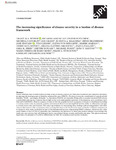2021-07-02Zeitschriftenartikel
The increasing significance of disease severity in a burden of disease framework
Wyper, Grant M. A.
Assuncao, Ricardo
Fletcher, Eilidh
Gourley, Michelle
Grant, Ian
Haagsma, Juanita A.
Hilderink, Henk
Idavain, Jane
Lesnik, Tina
von der Lippe, Elena
Majdan, Marek
Mccartney, Gerry
Santric-Milicevic, Milena
Pallari, Elena
Pires, Sara M.
Plass, Dietrich
Porst, Michael
Santos, João V.
de Haro Moro, Maria Teresa
Stockton, Diane L.
Devleesschauwer, Brecht
Recent estimates have reiterated that non-fatal causes of disease, such as low back pain, headaches and depressive disorders, are amongst the leading causes of disability-adjusted life years (DALYs). For these causes, the contribution of years lived with disability (YLD) – put simply, ill-health – is what drives DALYs, not mortality. Being able to monitor trends in YLD closely is particularly relevant for countries that sit high on the socio-demographic spectrum of development, as it contributes more than half of all DALYs. There is a paucity of data on how the population-level occurrence of disease is distributed according to severity, and as such, the majority of global and national efforts in monitoring YLD lack the ability to differentiate changes in severity across time and location. This raises uncertainties in interpreting these findings without triangulation with other relevant data sources. Our commentary aims to bring this issue to the forefront for users of burden of disease estimates, as its impact is often easily overlooked as part of the fundamental process of generating DALY estimates. Moreover, the wider health harms of the COVID-19 pandemic have underlined the likelihood of latent and delayed demand in accessing vital health and care services that will ultimately lead to exacerbated disease severity and health outcomes. This places increased importance on attempts to be able to differentiate by both the occurrence and severity of disease.
Files in this item
Related Items
Show related Items with similar Title, Author, Creator or Subject.
-
2013-06-06ZeitschriftenartikelTravel-associated Legionnaires’ disease in Europe, 2010 Jong, B. de; Hallström, L. Payne; Robesyn, E.; Ursut, D.; Zucs, PhillipIn 2010, the European surveillance network for travel-associated Legionnaires’ disease (ELDSNet, previously EWGLINET) received reports of 864 cases of travel-associated Legionnaires’ disease, of whom 24 were reported to ...
-
2013-02-19ZeitschriftenartikelLymphogranuloma Venereum in Men Screened for Pharyngeal and Rectal Infection, Germany Haar, Karin; Dudareva-Vizule, Sandra; Wisplinghoff, Hilmar; Wisplinghoff, Fabian; Sailer, Andrea; Jansen, Klaus; Henrich, Birgit; Marcus, UlrichTo determine prevalence of lymphogranuloma venereum among men who have sex with men in Germany, we conducted a multicenter study during 2009–2010 and found high rates of rectal and pharyngeal infection in men positive for ...
-
2009-10-15ZeitschriftenartikelLow ankle-brachial index predicts cardiovascular risk after acute ischemic stroke or transient ischemic attack Busch, Markus; Lutz, Katrin; Röhl, Jens-Eric; Neuner, Bruno; Masuhr, FlorianBackground and purpose: A low ankle-brachial blood pressure index (ABI) is an established risk marker for cardiovascular disease and mortality in the general population, but little is known about its prognostic value in ...

